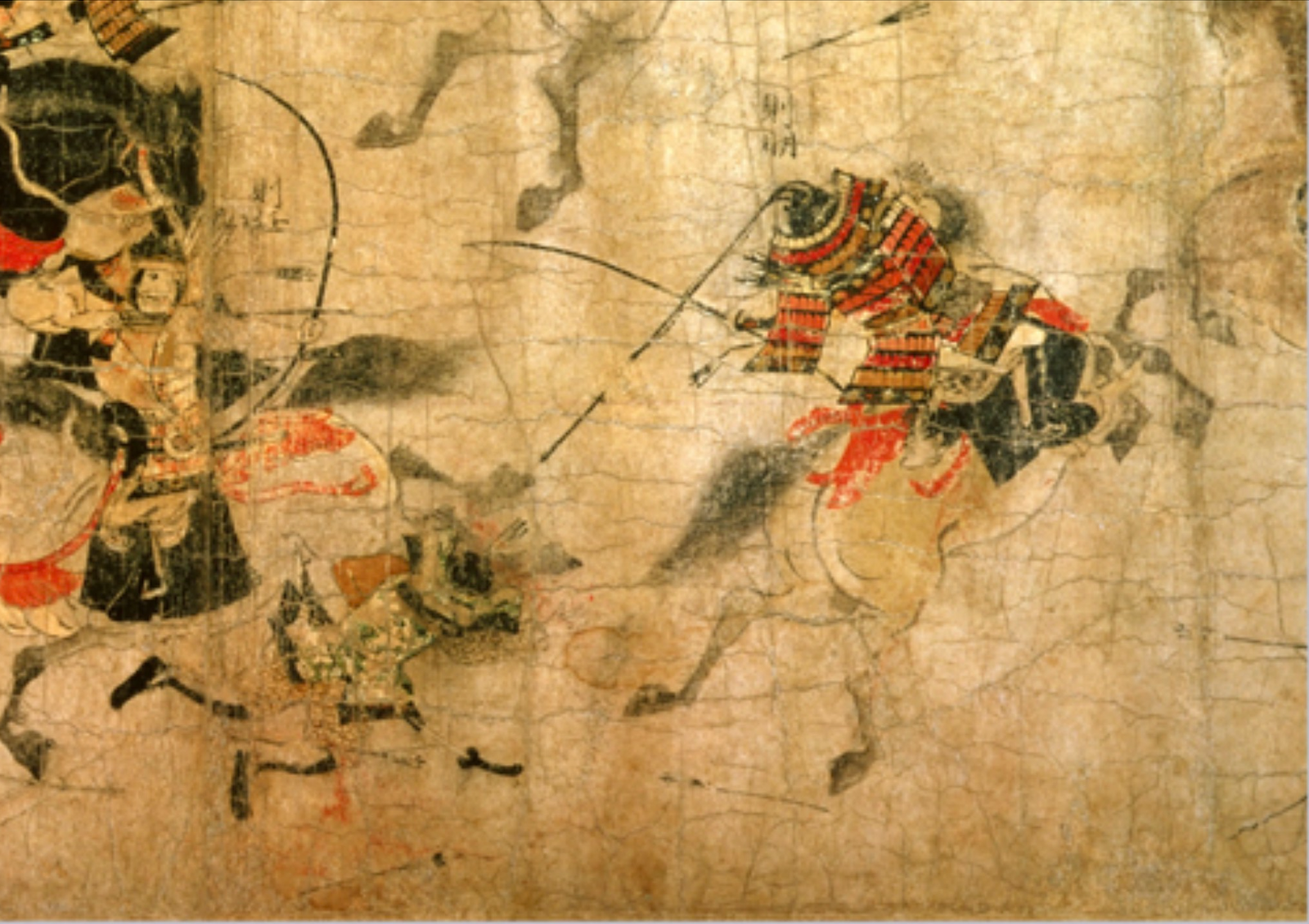 |
| From the Scroll of the Mongol Invasion (Mōko Shūrai Ekotoba) - a fine example of a kumade in the centre. |
Today, seeing the leaves beginning to turn to the gold of autumn, I was reminded of that perennial garden chore, raking leaves. It made me think of a reference I came across regarding a certain Matsuda Hidenobu, a warrior of some note who fought at the battle of Sekigahara (1600) during which he is reported to have used a long weapon called a kumade (literally ‘bear’s claw’) to bring down 11 mounted opponents whom his followers then dispatched. What had caught my eye was that the weapon he was depicted with was a large leaf rake (see below).
 |
| Chicken or egg? One of these is clearly derived from the other, but they both have poor old Matsuda using a leaf rake. |
While it is true that the same word, kumade, is used for a modern leaf rake, this is very far from the weapon that Matsuda Hidenobu must have used.
The word ‘battlefield’ is often bandied about with regard to traditional martial arts – some of them really were created for or used on battlefields; others are more likely to have developed for civilian self-protection in what were very violent times. Some were probably meant as a kind of training to imbue discipline and other virtues in a suitable cultural package. Many are hybrids, adapting and developing military techniques for other purposes. But early examples of the use of the kumade can, indeed, be located on battlefields in early medieval Japan.
This can be seen in artwork such as the Kasuga Gongen E-Maki (early 14th century - see above) and in the well known Scroll of the Mongol Invasion (13th century), and several instances appear in war chronicles, both on land and at sea. Set at an earlier date than both the aforementioned scrolls, the story of Taira no Yorimori being attacked by one Hachimachi Jiro, who hooked a rake onto his helmet, only for Yorimori to reverse the tables by cutting through the shaft of the kumade with his sword, the famous Nuke-maru, sending Jiro tumbling, and returning to camp with the kumade still attached to his helmet, has a ring of truth to it, despite the clearly fictional basis of many of the individual exploits in these tales. These tales and picture scrolls were mostly created well after the periods they depict (not in the case of the Mongol Invasion scroll, however), but still in a time of pretty constant warfare, so they can be considered reasonably reliable in the weapons they depict.
Doubling as a weapon and a tool, it is difficult to ascertain the origins of this device, but its similarity to the kind of anchor used by small boats suggests this is a possible source. It is often depicted with a rope or chain wound around the shaft, and although I have seen no depictions (or read any accounts) of how this was used, it suggests the head may not have been too firmly fixed on the shaft and the rope/chain served as an additional means of controlling the opponent if the head became detached (or if the shaft was cut through, as in the story above).
Not surprisingly, it was used differently on land and at sea. On land, it seems to have been used both by foot soldiers and mounted warriors, principally as a means of pulling armoured riders off their mounts – a useful tactic, especially given the amount of cordage and loose fitting pieces that made up Japanese armour. At sea, it could be used not only to grapple with enemy boats, but accounts also note its use in rescuing comrades who had fallen into the water.
Although it seems to have been effective, it was not particularly common. With the weight concentrated at one end, it is likely it was less well-balanced than more typical spears and naginata. Both Musashibo Benkei, legendary retainer of Minamoto Yoshitsune, who carried it as one of his seven weapons/tools, (which also included a large mallet, a broad-bladed axe and an iron staff, all of which were meant to indicate his strength) and the aforementioned Hachimachi Jiro, were warriors of more than average strength, and it may well be that it was, indeed, heavier and less wieldy than more common weapons.
 |
| A close-up from the Denshoubi showing a hybrid rake-like weapon |
That it was used by Matsuda Hidenobu in the battle of Sekigahara, suggests it continued to be used throughout the Sengoku period, and perhaps beyond. The fact that surprisingly few examples have survived to the present day suggests it quickly fell out of favour, perhaps to be replaced by other weapons more suitable to the demands of new era. A screen painted around 1614 (the Denshoubi probably by Iwasa Matabei) depicting scenes in Kyoto, shows what looks like a kumade, together with other pole arms, on display at a theatre. Here, however, it seems to have assumed something of a civic role, as something symbolic or to be used in a crowd control function. I believe that it is in this guise that it continued up the the modern era - more of that next time.
 |
| One last picture of Matsuda Hidenobu with his leaf rake.It looks like it is from one of the Osprey publications, but it shows the difficulty of finding accurate source material. |


